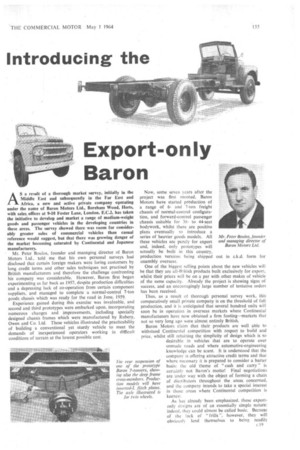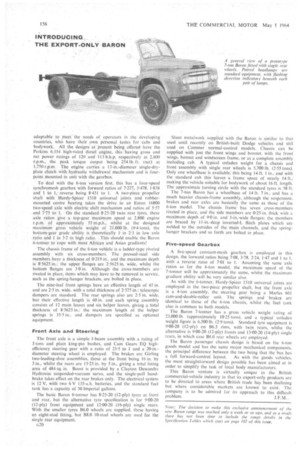Introducing the
Page 157

Page 158

If you've noticed an error in this article please click here to report it so we can fix it.
Export-only Baron
S a result of a thorough market survey, initially in the
Middle East and subsequently in the Far East and
Africa, a new and active private company operating under the name of Baron Motors Ltd., Boreham Wood, Herts, with sales_offices at 9-10 Foster Lane, London, E.C.2, has taken the initiative to develop and market a range of medium-weight goods and passenger vehicles in the developing countries in these areas. The survey showed there was room for considerably greater sales of commercialvehicles than casual reference would suggest, but that there was growing danger of the market becoming saturated by Continental and Japanese manufacturers Mr. Peter Boulos, founder and managing director of Baron Motors Ltd., told me that his own personal surveys had disclosed that certain foreign makers were luring customers by long credit terms and other sales techniques not practised by British manufacturers and therefore the challenge confronting his company was considerable. However, Baron first began experimenting as far back as 1957, despite production difficulties and a depressing lack of co-operation from certain component suppliers, and managed to complete a normal-control 7-ton goods chassis which was ready for the road in June, 1959.
Experience gained during this exercise was invaluable, and second and third prototypes were embarked upon, incorporating numerous changes and improvements, including specially designed chassis frames which were manufactured by Rubery, Owen and Co. Ltd. These vehicles illustrated the practicability of building a conventional yet sturdy vehicle to meet the demands of inexperienced operators working in difficult conditions of terrain at the lowest possible cost.
Now, some seven years after the project was first mooted, Baron Motors have started prOduction of a range of 6and 7-ton freight chassis of normal-control configuration, and forward-control passenger chassis suitable for 38to 44-seat bodywork, whilst there are positive plans eventually to introduce a series of heavier goods models. All these vehicles are purely for export and, indeed, only prototypes will actually be built in this country, production versions being shipped out in c.k.d. form for assembly overseas.
One of the biggest selling points about the new vehicles will be that they are all-British products built exclusively for export, whilst their prices will be on a par with other makes of vehicle of the same capacity. Already the project is showing signs of success, and an encouragingly large number of tentative orders has been received.
Thus, as a result ot thorough personal survey work, this comparatively small private company is on the threshold of full production, and it is anticipated that several hundred units will Won be in operation in overseas markets where Continental manufacturers have now obtained a firm footing—markets that not so very long ago were almost entirely British.
Baron Motors claim that their products are well able to withstand Continental competition with respect to build and price, whilst still retaining the simplicity of design which is so desirable in vehicles that are to operate over• unmade roads and where automotive-engineering knowledge can be scant. It is understood that the company is offering attractive credit terms and that where necessary it is prepared to consider a barter basis: the old theme of "cash and carry" is certainly not Baron's motto! Final negotiations are under way with the object of forming a chain of distributors throughout the areas, concerned, and the company intends to take a special interest in those areas where Continental competition is keenest.
Mr. Peter Bottles, founder and managing director of Baron Motors Ltd.
As has already been emphasized. these exportonly designs are of an essentially simple nature: indeed, they could almost be called basic. Because of the lack of " frills", however, they will obviousl lend themselves to being readily adaptable to meet the needs of operators in the developing countries, who have their own personal tastes for cabs and bodywork. All the designs at present being offered have the Perkins 6.354 high-rated diesel engine, this having gross and net power ratings of 120 and 113 b.h.p. respectively at 2,800 r.p.m., the peak torque output being 254 lb. ft. (net) at 1,750 r.p.m. The engine carries a 13-in.-diameter single-dryplate clutch with hydraulic withdrawal mechanism and is fourpoint mounted in unit with the gearbox.
To deal with the 6-ton version first, this has a four-speed synchromesh gearbox with forward ratios of 7.227, 3.478, 1.838 and 1 to 1, reverse being 8-431 to L A two-piece propeller shaft with Hardy-Spicer 1510 universal joints and rubbermounted centre bearing takes the drive to an Eaton 16800 two-speed axle with electric shift mechanism and ratios of 5-57 and 7.75 to 1. On the standard 8-25-20 twin rear tyres, these axle ratios give a top-gear maximum speed at 2.800 engine r.p.m. of approximately 55 m.p.h.. whilst at the designed maximum gross vehicle weight of 21,000 16. (9-4 tons), the bottom-gear grade ability is theoretically 1in 2.3 in low axle ratio and 1 in 3.2 in high ratio. This should enable the Baron 6-toriner to cope with Most African and Asian gradients!
The chassis frame of the 6-ton vehicle is a ladder-type riveted assembly with six cross-members. The pressed-steel side members have a thickness of 0-219 in.. and the maximum depth is 8-5625 in.: the upper 'flanges are 2.5625 in, wide, whilst the bottom flanges are 3-0 in. Although the cross-members are riveted in place, items which may have to be removed in service, such as the spring-hanger brackets, are bolted in place.
The nine-leaf front springs have an effective length of 45 in. and are 2.5 in. wide, with a total thickness of 2.375 in.: telescopic dampers are standard. The rear springs also are 2.5 in. wide, but their effective length is 60 in, and each spring assembly consists of 12 main leaves and six helper leaves, giving a total thickness of 8-5625 in.: the maximum length of the helper springs is 35.5 in.. and dampers are specified as optional equipment.
Front Axle and Steering
The front axle is a simple I-beam assembly with a rating of 3 tons and plain king-pin bushes, and Cam Gears EQ highefficiency steering gear with a ratio of 23-5 to 1 and a 20-in.diameter steering wheel is employed. The brakes are Girling two-leading-shoe assemblies, those at the front being 16 in. by 3 in., whilst the rears are 15.25 in. by Sin., giving a total lining area of 484 sq. in. Boost is provided by a Clayton Dewandre Hydrovac suspended-vacuum servo, and the single-pull handbrake takes effect on the rear brakes only. The electrical system is 12 V, with two 6 V 135-a.h. batteries, and the standard fuel tank has a capacity of 30 Imperial gallons.
The basic Baron 6-tonner has 8.25-20 (12-ply) tyres at front and rear, but the alternative tyre specification is for 9.00-20 (12-ply) front equipment and 12.00-20 (16-ply) single rears. With the smaller tyres B6.0 wheels are supplied, these having an eight-stud fitting, but B8.0 10-stud wheels are used for the single rear equipment.
G20 Sheet metalwork supplied with the Baron is similar to that used until recently on British-built Dodge vehicles and still used on Commer normal-control models. Chassis can be supplied with just the front wings and bonnet, with the front wings. bonnet and windscreen frame, or as a complete assembly including cab. A typical unladen weight for a chassis and front assembly . with single rear wheels is .5,700 lb. (2-55 tons). Only one wheelbase is available, this being 14-ft. 1 in., and with the standard cab this leaves a frame space of nearly 14 ft.; making the vehicle suitable for bodywork of about 16 ft. length. The approximate turning circle with the standard tyres is 58 ft.
The 7-ton Baron has a wheelbase of 14 ft. 7 in., and has a much heavier chassis-frame assembly, although the suspension. brakes and rear axles are basically the same as those of the 6-tort model. The chassis frame has seven cross-members riveted in place, and the side members are 0-25 in. thick with a maximum depth of 9.0 in. and 3-in.-wide flanges: the members are braced by 11-in.-deep inverted-L flitch plates which are welded to the outsides of the main channels, and the springhanger brackets and so forth are bolted in place.
Five-speed Gearbox
A five-speed constant-mesh gearbox is employed in this design, the forward.ratios being 7.08, 3-78, 2.24, 1.47 and 1 to I. with a reverse ratio of 7-01 to I. Assuming the same axle ratios as for the 6-ton model, the maximum speed of the 7-tonner will be approximately the same, whilst the maximum gradient ability will be very similar also.
As with the ti-tonner. Hardy-Spicer 1510 universal joints are employed in the two-piece propeller shaft, but the front axle is a 4-ton assembly. the steering gear being a Marles 661 cam-and-double-roller unit. The springs. and brakes are identical to those of the 6-ton chassis, whilst the fuel tank also is common to both models.
The Baron 7-tonner has a gross vehicle weight rating of 23,000 lb, (approximately 10-25 tons), and a typical unladen weight figure is 6,500 lb. (2.9 tons). Standard tyre equipment is 9.00-20 (12-ply) on B6.5 rims, with twin rears, whilst the alternative is 9.00-20 (12-ply) fronts and 13-00-20 (14-ply) single rears, in which case B8.0 rear wheels are employed.
The Baron passenger chassis design is based on the 6-ton goods Model and has the same major mechanical components. the principal difference between the two being that the bus has a full forward-control layout. As with the goods vehicles, the most straightforward design possible has been aimed at in order to simplify the task of local body manufacturers.
This Baron venture is virtually unique in the British commercial-vehicle industry in that its export-only products are to be directed to areas where British trade ha,.s been declining but where considerable markets are known to exist. The company is to be admired for its approach to this difficult
problem. J.F.M.
Note: The decision to make this exclusive announcement of the new .Baron range was reached only a week or so ago, and as a result there has not been time to include the range details in the Specification Tables which start on page 102 of this issue.




















































































































































































































































